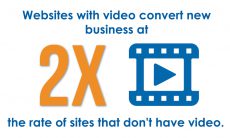Over the last couple of years, Connected TV, via channels like Hulu and IMDB, has emerged as a productive new advertising medium. CTV offers two key benefits: precise household-level targeting, and accurate tracking for attribution. Which is exactly what B2B marketers need: zero waste and clear accountability.
Many B2B marketers have historically avoided broadcast advertising, due to the big buys required, and the enormous waste. So, why is CTV different? Here are seven reasons.
Laser targeting. Compared to linear TV, where the waste that characterizes mass media has kept B2B marketers away, CTV allows precise targeting at the individual level, based on 3rd party database variables like company size, industry, job role, intent and other typical in B2B media buying. You can also use your first party data for targeting and retargeting, to existing names as well as lookalikes, the same way you would in other digital media channels. (CTV is perfect for ABM.)
Omni-channel integration. As work-from-home has grown, B2B marketers understand that they need to be wherever their prospects and customers are. They are watching CTV. Take advantage.
Accurate tracking. B2B marketers who complain about attribution problems in multi-touch communications will find deep satisfaction here. You can track site visits and form fills straight back to the CTV impression.
Lower CPM rates overall. CPM rates on CTV are higher, to be sure. But when you factor in the precise targeting and the reduced waste, you’ll realize dramatically lower rates. Not to mention the cost—and quality—per lead.
The medium of the future. Initial experiments suggest that CTV is especially good for connecting with younger audiences, the millennials and gen-Xers who are rapidly entering the buying group at your target accounts.
Less competitive clutter. The medium is still in its infancy. So, this is the time to test it out, and experiment with targeting options, offers and creatives, while your competitors are still asleep.
High impact messaging for a complex sale. CTV ads can’t be fast forwarded. So, you can rely on the full 15 or 30 seconds to get your point across, in a medium that has far higher recall than other digital channels.
A case in point comes from Hamid Qayyum, EVP of product and marketing at Stirista, in San Antonio. Stirista ran a B2B CTV campaign for a telecom company targeting SMBs, in May. Stirista matched the ad impressions to the client’s website visits, revealing 2,151 matches (2.3% of their total SMB site traffic), despite running in just a couple of their focus markets.
Caveats
No matter how precise, most of your targeting will be at the household level. So, there will still be some waste, as you reach children or spouses of your business prospect. You are also dependent on match the rates with your 1st and 3rd party data, so don’t expect 100% access.
If you are looking for volume, keep in mind that CTV advertising is growing rapidly but still comprises only 4.2% of total media spend. Fortunately, most B2B marketers care more about cost-per-response, where CTV offers a distinct advantage.
One thing that perplexes me, though, is why the CTV advertising we are seeing today seems to be structured as strictly branding and awareness messaging. B2B marketers typically evaluate media on response metrics like cost-per-lead and conversion rates. I advise B2B marketers to approach CTV the same way they would any digital channel: As an opportunity to engage, generate a response, and develop a lead, and kick off a long-term relationship. This means adding an offer, a call to action and a response vehicle, like a short SMS code or a unique URL. Consider the awareness a bonus. B2B marketers, this is the time to test out CTV.







